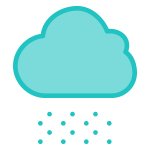
Article
5 min read
How To Better Predict Customer Flow
Brett Smith
Sep 15, 2017
Chapters
How to better predict customer flow
For restaurant managers, a crystal ball would come in pretty handy. Looking into the future, they would know exactly how many customers to expect each day and, in turn, how many staff members they need to have on duty.
Unfortunately, predicting customer flow isn't that easy. But it's an important skill for restaurant managers to hone. When customer flow is higher than you anticipate, understaffing can damage customers' experience, making them less likely to return or to recommend your restaurant to others. When it's lower, overstaffing raises your labor costs and cuts into profitability.
So without that crystal ball, how can you get better at predicting customer flow and staffing your restaurant accordingly? We've got a few strategies.
Keep an eye on your competitors
Developments at other restaurants in your market can affect your business. If a competitor opens — or closes — a location near you, you're likely to see the impact on your customer flow. Beyond openings and closing, a change in your competitors' public image could also be a factor in how full your restaurant is. If a rival restaurant earns a great review in a local magazine, they could lure some customers away from you (at least for awhile). But if they make a social media misstep that goes viral, their regulars might defect to you.
Plan for holidays
Holidays will definitely have an effect on your customer flow. But what that effect is depends on the holiday and on your restaurant. Fx, quick-servicerestaurants could see an uptick during the winter holiday season because people are busier. On the other hand, table-service restaurants will likely see more customers around special occasions like Valentine's Day and Mother's Day that are more associated with dining out.
Change with the seasons
Your customer flow and staffing needs will vary depending on the season. In an article for QSR, some restaurants report that they usually see major slowdowns when nasty winter weather hits, while others say they've found ways to thrive. Toppers, a pizza chain concentrated in the Northwest, told QSR they even implement "all hands on deck" staffing during snowy weather because they have a reputation as the last pizza place open in bad weather. On the other hand, summer often means bigger crowds because of the nicer weather and, depending on where you are, an influx of tourists.
Be Aware of Local Events
A big happening in town could translate to heavier crowds at your restaurant. For example, the South by Southwest festival and conference had an economic impact of more than $325 million on Austin, Texas, in 2016 and brought 140,000 people to town. Restaurants are one of the main sectors benefiting from this economic boost. But event crowds don't have to be SXSW-sized to have an impact on your business and your staffing needs. Information from the chamber of commerce, convention and visitors bureau or local news websites can help you stay up to date on upcoming events.
Monitor the economy
As anyone in the business who weathered the recession of 2008 can tell you, restaurant performance is tied to the health of the overall economy. Staying informed on local and national news, as well as industry-wide developments, can help you predict changes in your customer flow. Trends that might not seem related to restaurants — such as medical, housing and grocery costs — actually have a huge bearing on business because they affect how much money consumers have available for dining out. Reports like NPD's make it easier to keep on top of economic news and predict how it will affect your business.
Put data to work for you
You can more effectively measure the impact of all of these factors, plus track other business patternsat you restaurant, if you make smart use of data. This is one reason it's important to invest in a point-of-sale (POS) system for your restaurant. A POS system can track information like sales and your most popular menu items so that you can look at what's happened in the past for clues on predicting future business and staffing needs. According to Toast Restaurant Management Blog, this process is called activity-based forecasting. To try it yourself, start by examining your POS records from the past few scheduling periods and looking for trends. Next, adjust your scheduling based on those trends.
We also recommend
Another tool to utilize is an employee scheduling software, which lets you look at how much staff you've had on specific days in the past. Some softwares also integrates with several different POS systems.
If you're ready to become even more data-driven, the website DataInformed reports that advanced analytics services are now more affordable than ever and thus within reach for more restaurants. With advanced analytics, restaurants can go beyond looking at what happened in the past to understanding why it happened. That's not quite a crystal ball — but it's awfully close.

Customer Acquisition: The Complete Guide
No matter how good their product or service is, a business still needs a strong customer acquisition strategy to keep afloat

12 Customer Acquisition Channels and How to Choose the Right Ones
.


